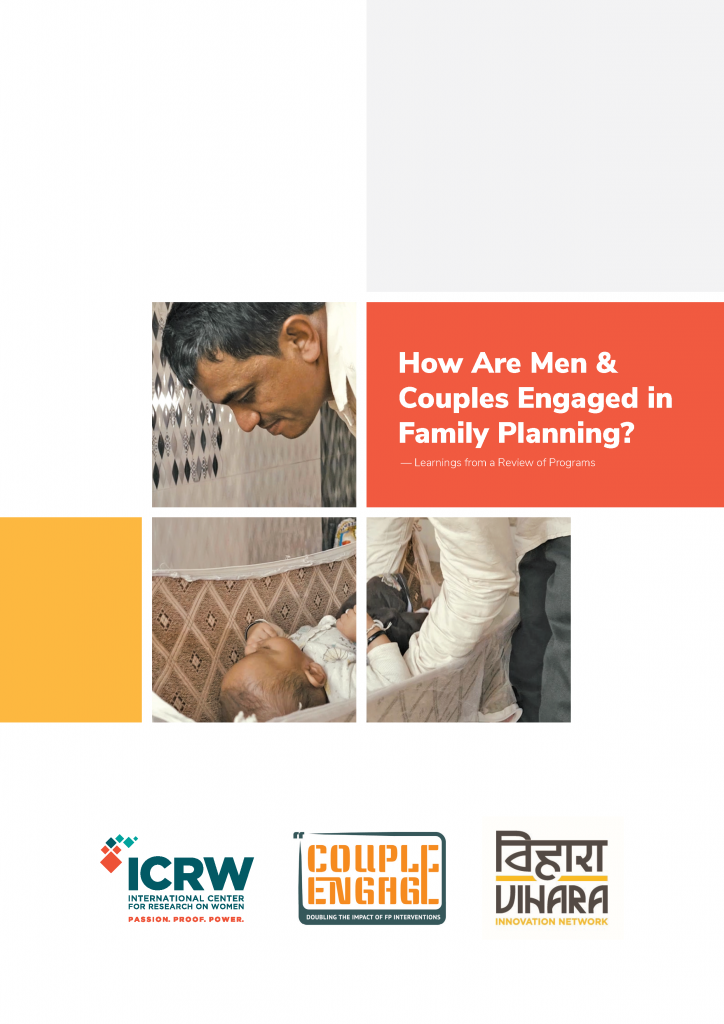
How Are Men & Couples Engaged in Family Planning?
Family Planning, Men and Masculinities, Sexual and Reproductive Health and Rights
Learnings from a Review of Programs
2021
 This report presents learnings and insights from the Couple Engage project—carried out by The International Center for Research on Women (ICRW) in partnership with Vihara Innovation Network—to develop gender-equitable approaches regarding male engagement for spacing methods. Focused on Uttar Pradesh and Bihar, India, the project used an evidence-driven approach to provide pathways and solutions to increase family planning among young men and couples through literature review and human-centered design (HCD).
This report presents learnings and insights from the Couple Engage project—carried out by The International Center for Research on Women (ICRW) in partnership with Vihara Innovation Network—to develop gender-equitable approaches regarding male engagement for spacing methods. Focused on Uttar Pradesh and Bihar, India, the project used an evidence-driven approach to provide pathways and solutions to increase family planning among young men and couples through literature review and human-centered design (HCD).
Key Findings
Using a gender lens, this review creates a nuanced understanding of the various approaches and communication channels that family planning programs use for engaging men in different roles — as clients, influencers and partners. This review outlines the need for family planning programs to recognize the value of engaging men as supportive partners. This could make men more accountable for their family planning choices and alter the lop-sided power dynamic between couples, which could help initiate better spousal communication and joint decision-making processes.
Review of evidence conducted under this project (Seth et al, 2020) suggests that the pathway to gender-equitable engagement of men and couples has interrelations with knowledge and power, both of which
together shape couples’ family planning choices. Keeping within the purview of these two pillars — knowledge and power — this programmatic review takes us a step further in understanding the multitude of strategies, channels and media used to engage men and couples, and the relevance of using a HCD approach in designing interventions.
Key Recommendations
- Formation of Community Change Clubs after the end of interventions: Programs should encourage community motivators/activists to form community change clubs (CCCs) to serve as peer support networks so that participants could continue dialogue on sensitive issues and seek support even after a program ends. Gender transformation is a long and arduous journey, and it is safe to assume that some men may still hold inequitable views on gender norms, have questions on several issues including HIV/STI prevention, contraceptive use, physical violence, domestic chores and parenting.
- Encourage simultaneous involvement of partners: Engaging both partners may be more effective in facilitating change in intimate relationships, provided both partners freely choose and desire this. Care needs to be taken to safeguard against increased risk of violence against women (Raising Voices, 2015). This also requires an understanding of the couple dynamic.
- Aspirational programming to catalyze growing conversation in couples: Community conversations, dramas and communication materials that are aspirational rather than punitive toward either sex can give participants practical ideas on how to talk about family planning and other relationship issues with others in the community. These types of activities also provide opportunities for practicing difficult one-on-one relationship discussions that people may wish to have with their partners (Raising Voices, 2015).
- Co-creation of knowledge and content with community: Knowledge and demand can be increased even in low-literacy settings, through information, content, and communications (IEC) that are properly developed with community inputs and feedback (Engender Health, 2005).
- Gender divide on access to technology: Although technological interventions are fast and upcoming, programs also point to the gender divide that exists in access and availability to digital platforms for women. For instance, in campaigns on abortion, women were more participative in reading the content, but they were not commenting whereas men would comment and participate. Therefore, maintaining anonymity is crucial for women while looking for personal insights, particularly in settings where many women do not have personal and secured access to technology.
- Women’s access to information: Equipping women and men with similar digital platforms is not enough, programs should also be mindful of the often-stringent restrictions and monitoring of content consumed by young women. Many women and adolescent girls remain deprived of reliable sources of information due to lack of freedom to access information around sexual intimacy, safe sex, family planning. Providing channels to girls and young women to consume information about their bodies without fear of backlash and negative implications is necessary for correct use of family planning.
- Sensitive Content Creation for Family Planning: Family planning is still an uncomfortable topic for many and therefore, content creation strategy must consider contextual sensibilities. Community influencers are usually comfortable talking about other issues such as finances and health of children. These could be used as entry points to layer family planning messaging for ensuring feasibility, both in terms of delivering such information and for community consumption.
Suggested Citation: Sahay, A., Joseph, J., Prashad, V.P., Yadav, K., Jha, S., Vachhar, K., Seth, K. 2021. “How are Men and Couples Engaged in Family Planning?” Learnings from a Review of Programs. New Delhi: International Center for Research on Women.
